Every child and family deserves access to affordable, quality physical and behavioral health care.
Quality and consistent preventive health care, beginning even before birth, gives children the best chance to grow up to be healthy and productive adults.
Children and families must be able to access and maintain affordable health insurance, and policies should maximize availability and robust investment in Medicaid and the Children’s Health Insurance Program. Our health care systems and policies should prioritize preventive services including immunization, developmental screenings, early intervention, and home visiting. Policies should promote timely and equitable access to a complete range of health care services within a healthy home and community-based environments for children and families across the lifespan.
Births
Births by Race & Ethnicity (2021)2
- White, non-Hispanic (68.1%)
- American Indian (1.0%)
- Asian/Pacific Islander
- Black/African American (6.2%)
- White, Hispanic (16.1%)
- Multi-racial and non-white, Hispanic (4.8%)
- White, non-Hispanic (68.1%)
- American Indian (1.0%)
- Asian/Pacific Islander
- Black/African American (6.2%)
- White, Hispanic (16.1%)
- Multi-racial and non-white, Hispanic (4.8%)
Trimester Prenatal Care Began (2021)2
- First Trimester (79.4%)
- Second Trimester (15.1%)
- Third Trimester (3.2%)
- None (0.9%)
- Unknown (1.4%)
- First Trimester (79.4%)
- Second Trimester (15.1%)
- Third Trimester (3.2%)
- None (0.9%)
- Unknown (1.4%)
24,609 babies were born in 2021.1
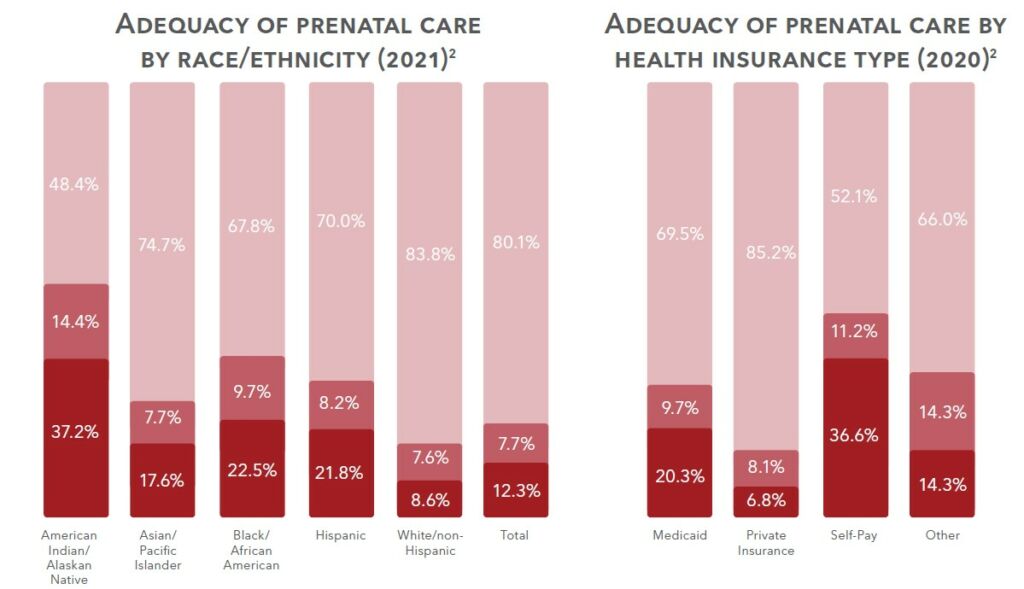
1. United States Department of Health and Human Services (US DHHS), Centers for Disease Control and Prevention (CDC), National Center for Health Statistics (NCHS), Division of Vital Statistics (DVS), Natality on CDC WONDER Online Database, for years 2016-2021 available February 2023.
2. National Center for Health Statistics, natality data, 2019-2021 average, Prepared by March of Dimes, Perinatal Data Center.
Pre/post-natal health
Tobacco Use (2021)1
- Did not use tobacco during most recent pregnancy (91.3%)
- Used tobacco during most recent pregnancy (6.4%)
- Used tobacco in the three (3) months prior to pregnancy (2.3%)
- Did not use tobacco during most recent pregnancy (91.3%)
- Used tobacco during most recent pregnancy (6.4%)
- Used tobacco in the three (3) months prior to pregnancy (2.3%)
Low Birth Weight (2021)1
- Not Low Birth Weight (2500+g) (92.3%)
- Moderately Low Birth Weight (1500-2499 g) (6.4%)
- Very Low Birth Weight (<1500 g) (1.3%)
- Not Low Birth Weight (2500+g) (92.3%)
- Moderately Low Birth Weight (1500-2499 g) (6.4%)
- Very Low Birth Weight (<1500 g) (1.3%)
12.0% of new mothers experienced postpartum depression symptoms related to their most recent pregnancy.2
3.3% of women had a home visitor during pregnancy to help prepare for the new baby.2

Teen births & sexual behavior
Teen Births
Teen births are at the lowest point in over a decade. In 2021 there were 944 babies born to teen mothers, 248 to mothers who were 10-17 years old, 696 to mothers who were 18 or 19.¹
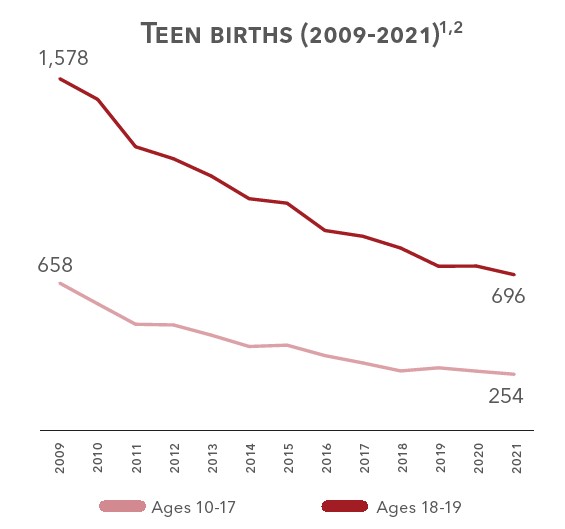
Teen births by age (2021)1
- Ages 18-19 (73.7%)
- Ages 16-17 (23.5%)
- Ages 14-15 (2.8%)
- Ages 18-19 (73.7%)
- Ages 16-17 (23.5%)
- Ages 14-15 (2.8%)
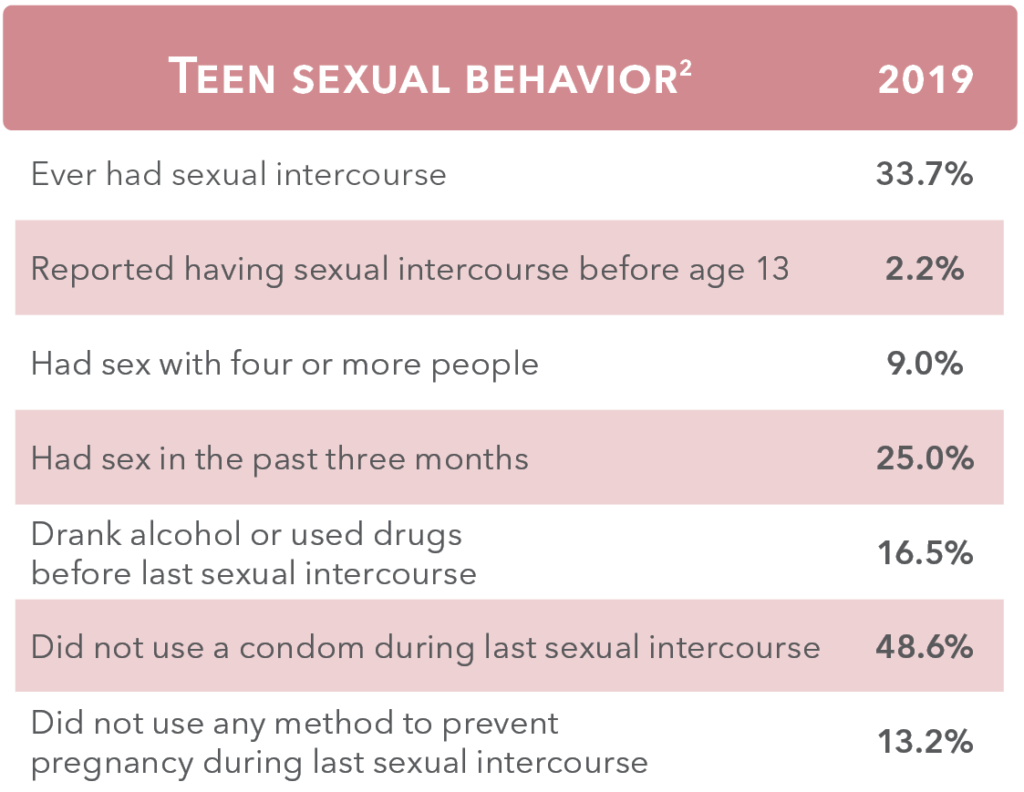
HIV/AIDS3
In 2021, there were less than five children ages 0-11 and 15 children ages 12-19 living with HIV.
Since 2008, between 1 and 5 children with a diagnosis of HIV or AIDS have died from the disease.*
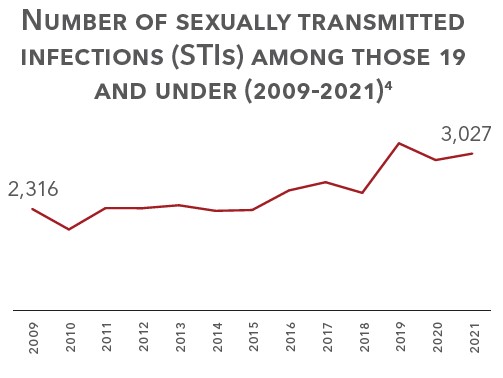
Sources:
1. United States Department of Health and Human Services (US DHHS), Centers for Disease Control and Prevention (CDC), National Center for Health Statistics (NCHS), Division of Vital Statistics (DVS), Natality on CDC WONDER Online Database, for years 2016-2021 available February 2023.
2. Center for Disease Control and Prevention, Youth Risk Behavior Survey, 2019.
3. HIV Surveillance, Nebraska Department of Health and Human Services.
4. Center for Disease Control and Prevention, Youth Risk Behavior Survey, 2019.
Infant & child deaths
Infant mortality
Infant mortality was 5.2 births per 1,000 births in 2021, a decrease from 5.7 (8.8%) in 2020.
Pregnancy deaths
16 women died in 2021 due to a cause related to or aggravated by pregnancy or its management.¹
Infant Mortality by Race/Ethnicity per 1,000 births (2020)2
Child Deaths, Ages 1-19 (2011-2021)1
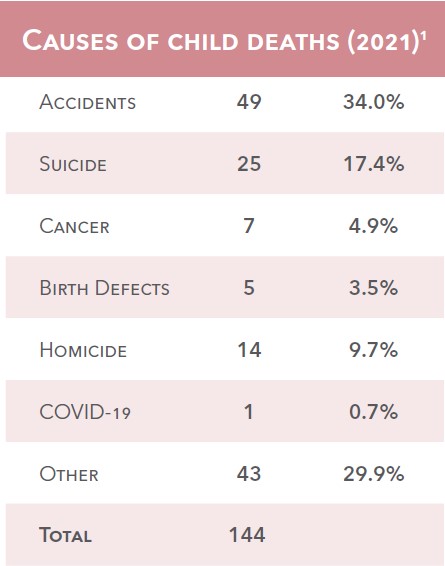
1. Vital Statistics, Department of Health and Human Services (DHHS).
2. United States Department of Health and Human Services (US DHHS), Centers for Disease Control and Prevention (CDC), National Center for Health Statistics (NCHS), Division of Vital Statistics, Natality on CDC WONDER Online Database, for years 2017-2020, available February 2023.
3. Kids Count 2021.
*Data counts suppressed due to privacy protection.
Health Insurance
Health coverage for Nebraska’s children, ages 18 & under (2021)1
- Any (94.6%)
- Public Insurance (26.3%)
- Employer-Based Insurance (55.7%)
- Direct-Purchase Insurance (6.1%)
- None (5.4%)
- More Than One Type (6.5%)
- Any (94.6%)
- Public Insurance (26.3%)
- Employer-Based Insurance (55.7%)
- Direct-Purchase Insurance (6.1%)
- None (5.4%)
- More Than One Type (6.5%)
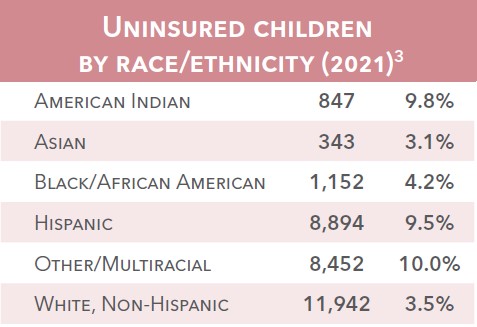
Access to health care
In 2021, there were 27,606 (5.4%) uninsured children in Nebraska. Of those, 11,901 (43.1%) were low-income (below 200% of the federal poverty level) and likely eligible, yet unenrolled in the Children’s Health Insurance Program (CHIP).¹
171,299 (31.2%) children were Enrolled in Medicaid/CHIP in SFY 2021.2
56.2% of those eligible for Medicaid/CHIP are children, but children only make up 22.2% of Medicaid costs.1
Medicaid/CHIP Eligibility by Category (SFY 2021)2*
- Blind/Disabled (12.1%)
- Aged (6.5%)
- Adults (25.2%)
- Children (56.2%)
- Blind/Disabled (12.1%)
- Aged (6.5%)
- Adults (25.2%)
- Children (56.2%)
Medicaid/Chip expenditures by Category (SFY 2021)2*
- Blind/Disabled
- Aged
- Adults
- Children
- Blind/Disabled
- Aged
- Adults
- Children
CHIP/Medicaid enrollment (SFY 2021)3
- Medicaid (89.1.%)
- CHIP (10.9%)
- Medicaid (89.1.%)
- CHIP (10.9%)
1. U.S. Census Bureau, 2021 American Community Survey 5-year estimates, Table B27010.
2. Nebraska Medicaid Annual Report for State Fiscal Year 2021.
3. U.S. Census Bureau, 2021 American Community Survey 1-year estimates, Table C27001B-I.
4. State Medicaid and CHIP Applications, Eligibility Determinations, and Enrollment Data.
* “Children” category combines Medicaid and CHIP coverage. “Adults” are those aged 19-64 receiving Aid to Dependent Children,
or temporary cash assistance through the state of Nebraska.
Behavioral Health
An estimated 20.2% Nebraska children have been diagnosed with a mental/behavioral condition needing treatment.1
Many children in Nebraska deal with behavioral health problems that may affect their ability to participate in normal childhood activities. The National Survey of Children’s Health estimates the number of Nebraska children facing the following disorders:¹
• Anxiety: 34,093
• ADD/ADHD: 30,143
• Depression: 17,912
• Autism Spectrum Disorder: 7,252

62.4% of children needing mental health counseling actually received it.¹
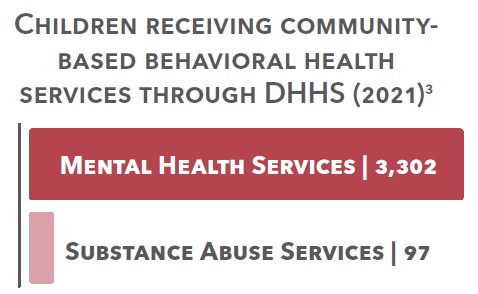
Regional centers (2021)3
40 Youths
received services at Hastings Regional Center, a chemical dependency program for youth from the Youth Rehabilitation & Treatment Center (YRTC) in Kearney.
127 youths
received services from Lincoln Regional Center at the Whitehall Campus.
83.9% of children six months to five years met all four measures of flourishing.¹
• Bounces back quickly when things don’t go their way
• Are affectionate and tender with their parent(s)
• Show interest and curiosity in learning new things
• Smile and laugh a lot
1. 2020-21 National Survey of Children’s Health, National
Outcome Measures.
2. 2019-2020 National Survey of Children’s Health, National
Outcome Measures.
3. Center for Disease Control and Prevention, Youth Risk
Behavior Survey, 2019.
4. Division of Behavioral Health, Department of Health and
Human Services.
5. Financial and Program Analysis Unit, Nebraska Department of Health and Human Services.
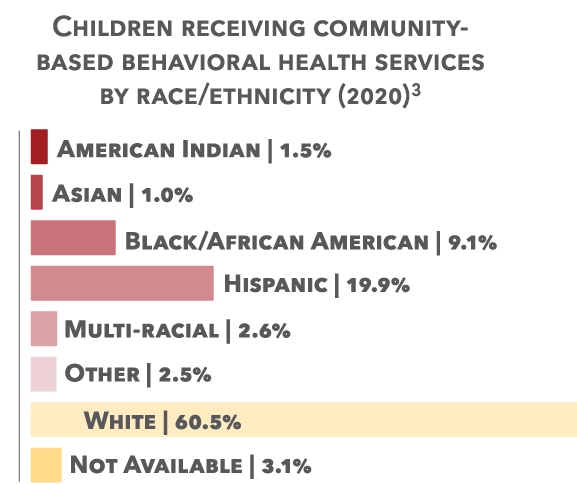
32,080 children received behavioral health services through Medicaid/CHIP from 1,246 providers (FY 2021).⁴
216 children received developmental services through Medicaid/CHIP (FY 2021).⁴
32.0% of teens felt sad or hopeless (everyday for 2+ weeks so that activity was stopped in last 12 months).²
Health Risks
7.4% of high schoolers rarely or never wore a seat belt.1
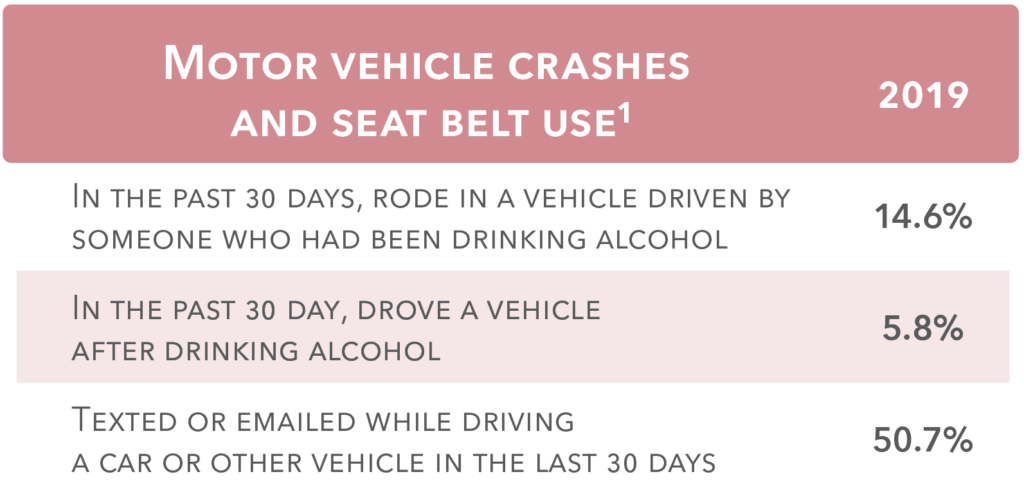
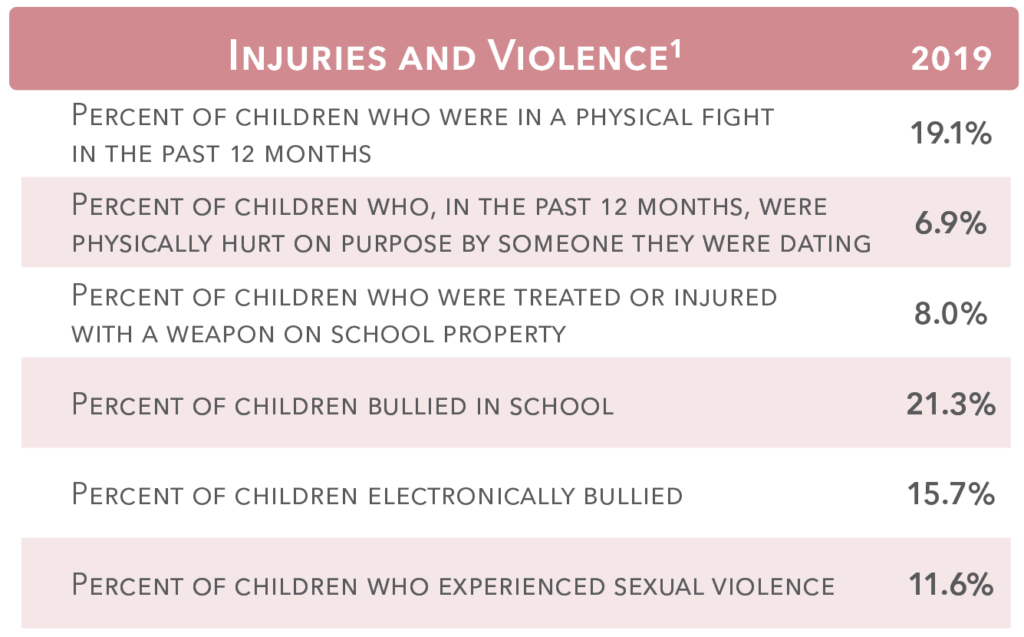
Motor vehicle accidents (2020)2
- 15 children died and 190 children suffered disabling injuries in motor vehicle accidents.
- 60.0% children who died were not wearing a seatbelt, 38.9% of those with disabling injuries were not wearing a seatbelt.
- Alcohol was involved in crashes resulting in 1 death and 10 disabling injuries.
Blood Lead Level Testing (2021)3
Exposure to lead may harm a child’s brain and central nervous system. Even low blood lead concentrations can
cause irreversible damage such as:
• impaired physical and cognitive development,
• delayed development,
• behavioral problems,
• hearing loss, and
• malnutrition.
In 2021: 33,503 children aged 0-6 had a blood lead level test.
488 had elevated
blood lead levels,
representing 1.5% of
all children tested.
92 Nebraska children ages 1-18 were injured by a firearm necessitating hospitalization in 2020.⁴
64 were due to
accidental discharge.
20 were due to assault.
2 were due to self-harm.
3 were due to legal intervention involving rubber bullet.
3 were undetermined.
64 were due to
accidental discharge.
20 were due to assault.
2 were due to self-harm.
3 were due to legal intervention involving rubber bullet.
3 were undetermined.
2. Nebraska Department of Transportation.
3. Childhood Lead Poisoning Prevention Program, Nebraska Department of Health and Human Services.
4. Nebraska Hospital Information System.
Health Risks
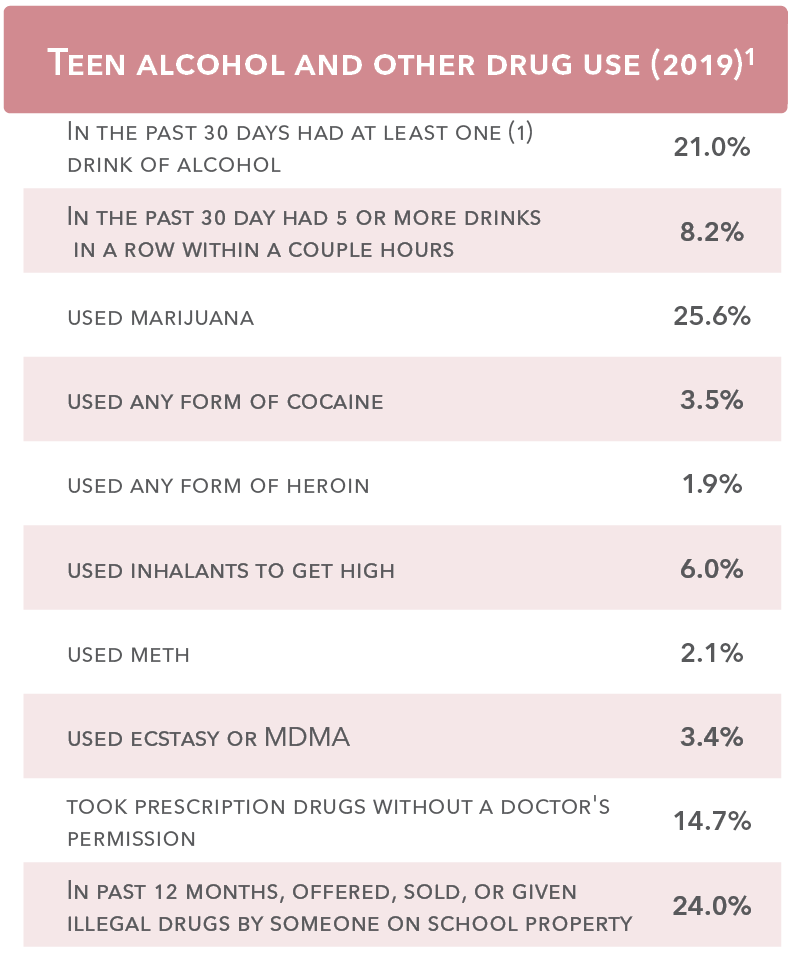
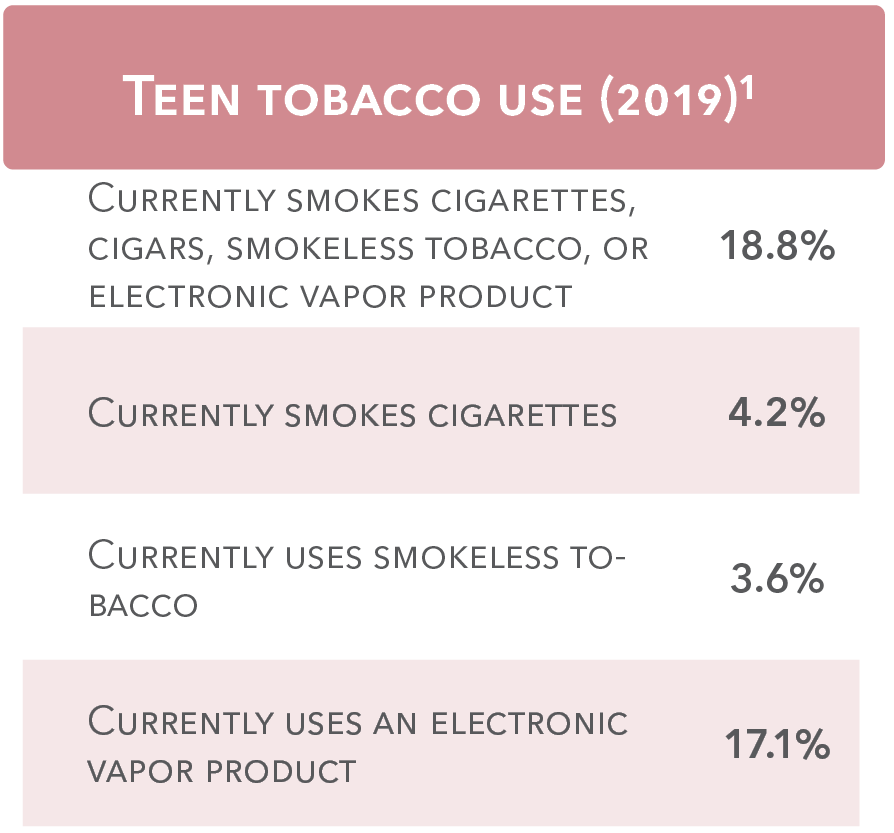
Domestic violence & sexual assault2
Nebraska’s Network of Domestic Violence/Sexual Assault Programs includes 20 community-based programs. There are also four tribal programs which comprise the Nebraska Tribal Coalition Ending Family Violence.
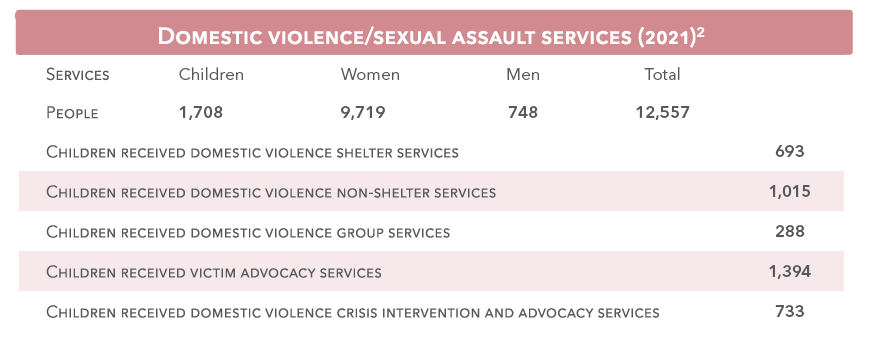
2. Nebraska Coalition to End Sexual and Domestic Violence.
Health Risks
Adverse Childhood Experiences
Adverse childhood experiences (ACEs) are potentially traumatic events that can have negative, lasting effects on health and well-being. Experiencing multiple ACEs results in compounding effects, and there is growing evidence that it is the general experience of multiple ACEs, rather than the specific individual impact of any one experience that matters. The experience of ACEs extends beyond the child and can cause consequences for the whole family and community.
Number Of ACEs Children Experience (2021)
- 0 ACE (65.1%
- 1 ACE (18.4%)
- 2+ ACEs (16.7%)
- 0 ACE (65.1%
- 1 ACE (18.4%)
- 2+ ACEs (16.7%)
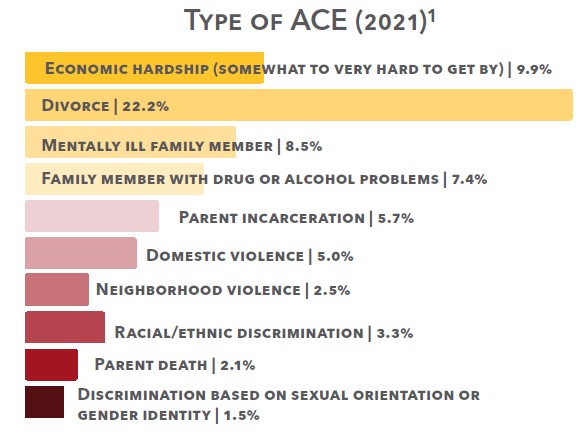
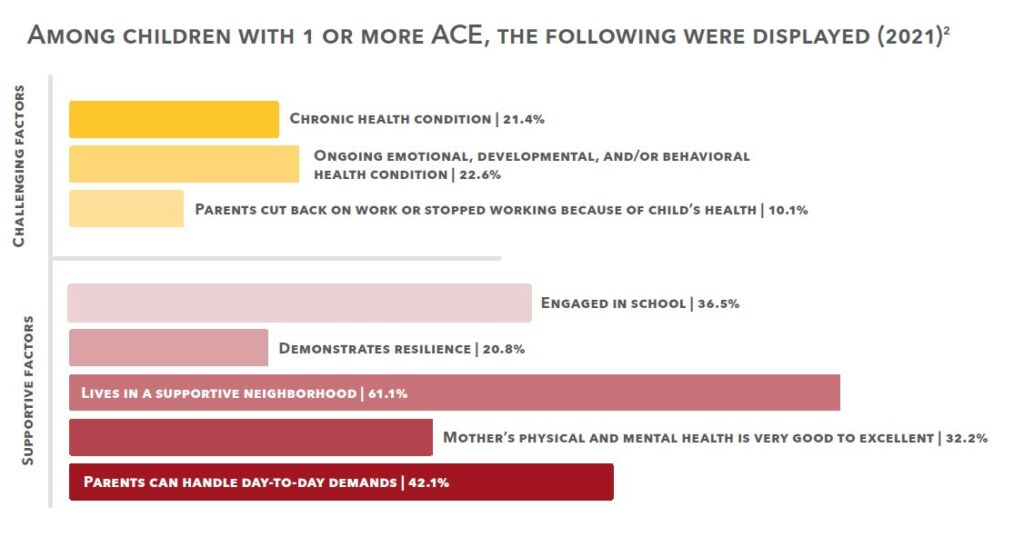
2. 2020-21 National Survey of Children’s Health.
Health Services
Health professional shortage areas are designations that indicate a shortage of health care providers in the areas of primary care, mental health care, or dental health care. Shortages fall into 3 categories:¹
1. Geographic areas – a shortage of providers for the entire population within an area
2. Population groups – a shortage of providers within an area for a specific high-need population
3. Facilities – health care facilities within an area have a shortage of health professionals to meet their needs
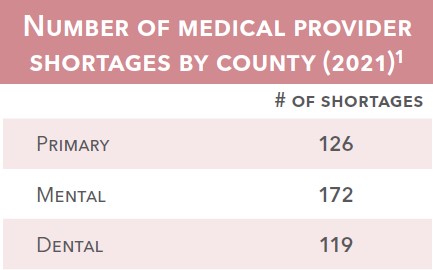

Immunizations (2020)2,3
77.7% of Nebraska children had received the primary immunization series* by age three.
87.3% of Nebraska teens were immunized against meningitis caused by types A, C, W, and Y.
62.2% of Nebraska teen girls and 67.3% of Nebraska teen boys completed their HPV vaccine series.
Children with a Medical home (2021)3
A patient-centered medical home is a primary care physician or provider that serves as a child’s usual source of care. It is an important mechanism for coordination of all segments of health – physical, behavioral, and oral.
- Have a medical home (52.4%)
- Do not have a medical home (47.6%)
75.0% of children had a preventive medical visit in the past year.4
79.3% of children had a preventive dental visit in the past year.4
33.0% of children had one or more current health conditions.4
93.9% of children are in very good to excellent health.4
1. Health Resources & Services Administration, Health Professional Shortange Areas.
2. National Immunization Survey-Child, 2020; Kids Count 2021.
*Series 4:3:1:3:3:1:4
3. National Immunization Survey-Child, 2020.
4. 2020-2021 National Survey of Children’s Health.

